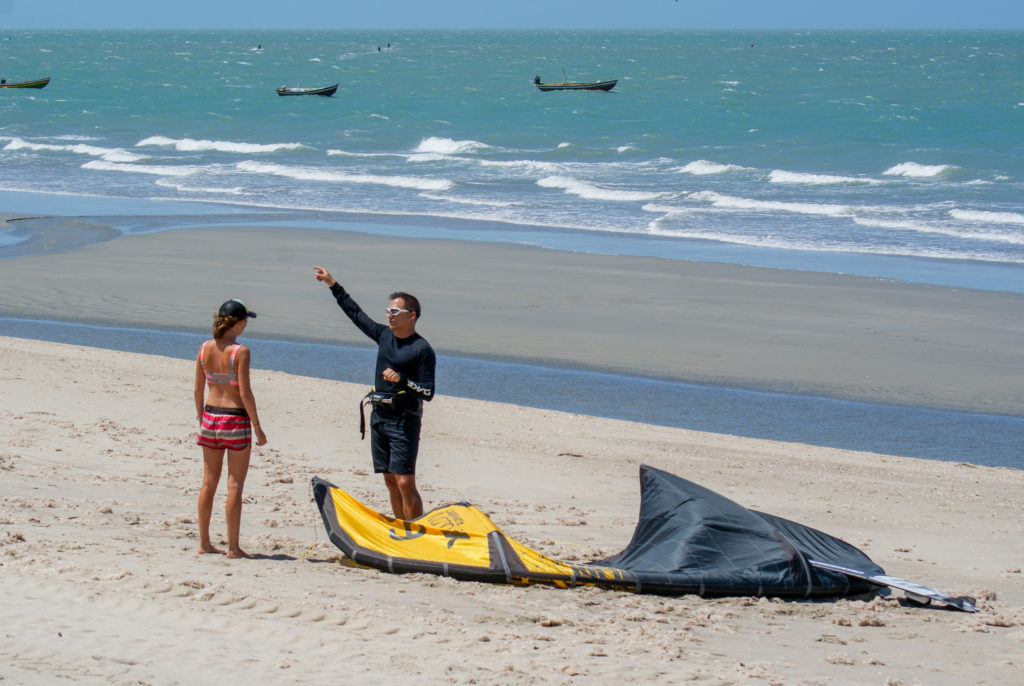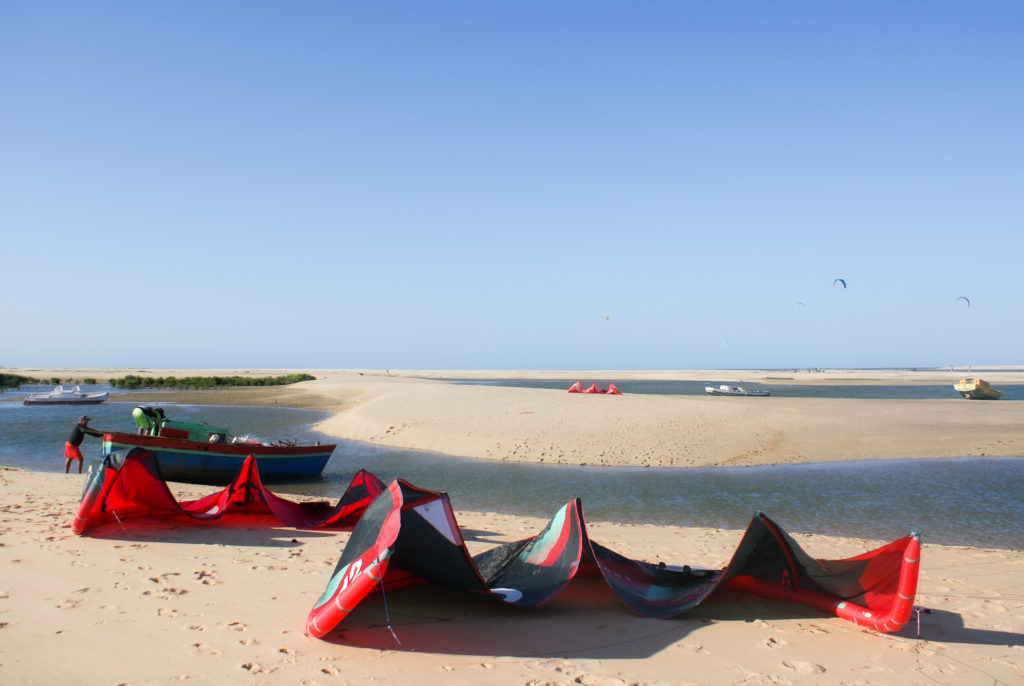Kitesurfing is an exciting sport that combines the energy of surfing with the freedom of flying. If you’re starting your journey in this thrilling sport, check out these essential tips for navigating safely and having fun.
1. Choose the right school
Start your kitesurfing adventure the right way; we at Oasis Kite Trip are here to help you find the perfect school. The quality of education you receive is crucial for your learning experience and, more importantly, for your safety. Instead of navigating alone through countless options, let our experienced team guide you to schools with certified instructors and proven reputations.
When working with us to select a school, you can expect:
- Personalized recommendations: Based on our knowledge and experience, we recommend schools that meet the highest standards of kitesurfing teaching and safety.
- Certified and experienced instructors: We ensure that recommended schools have instructors with recognized certifications, ensuring quality instruction and safe practices.
- Authentic feedback: We provide real insights and feedback from students who have already attended these schools, offering a transparent and reliable perspective.
- Access to cutting-edge equipment and safe facilities: The schools we recommend are well-equipped with the best gear and facilities suitable for effective and safe learning.
Remember, choosing the right school is not just about learning to maneuver a kite; it’s also about understanding kitesurfing culture, the importance of safety, and ethics in the sport. A quality kitesurfing school sets you on the right path to becoming not only a skilled practitioner but also a responsible and respected member of the kitesurfing community.

2. Private lessons: The best way to learn
When it comes to learning kitesurfing, private lessons represent an invaluable investment in your development. Unlike group lessons, private lessons offer a personalized approach, tailored entirely to your learning pace, skill level, and specific goals. With a dedicated instructor by your side, you can progress more quickly, focusing on areas where you need to improve the most.
Aspects to consider in private lessons include:
- Personalized attention: A private instructor can dedicate all their attention to you, ensuring you understand and correctly apply kitesurfing techniques.
- Accelerated progress: Without the limitations of a group, you can advance at your own pace, which often means learning more, in less time.
- Adaptation to individual needs: Whether you’re an absolute beginner or someone with some experience, private lessons are tailored to meet your specific needs.
Investing in private lessons is a wise choice for those who want to not only enjoy the sport but also master it with competence and safety. A private instructor can offer invaluable insights and tips, significantly speeding up your kitesurfing learning journey.

3. Knowing and setting up equipment
Mastering kitesurfing begins with a deep understanding of your equipment. Knowing each component of your kitesurfing kit – from the kite to the board, from the bar to the harness – is essential. More importantly, learning to set up and disassemble your equipment correctly is crucial to ensuring your safety and the longevity of your gear.
Fundamental aspects of equipment include:
- Inflating the kite correctly: Knowing how to inflate your kite in the correct direction and pressure is crucial. An improperly inflated kite can affect your performance and safety.
- Line setup: Learning to set up your lines correctly will prevent tangles and ensure effective control during kitesurfing.
- Harness adjustment: Well-adjusted harness enhances comfort and controls effort distribution, reducing the risk of injuries.
- Board knowledge: Understanding the different types of boards and their setups can help choose the most suitable for your style and kitesurfing conditions.
Dedicating time to know your equipment not only makes you a more competent kitesurfer but also more confident and secure. Familiarity with your gear allows you to react more effectively and safely in various conditions, providing a more enjoyable kitesurfing experience.

4. Understanding weather conditions
In kitesurfing, understanding weather conditions is as crucial as mastering the sport’s techniques. Kitesurfing heavily depends on wind conditions, which are influenced by a range of environmental factors, including tides, tidal coefficients, and even lunar phases. Knowing how to interpret and react to these conditions is essential for a safe and rewarding experience.
Important aspects to consider:
- Wind strength and direction: Understanding how to assess wind strength and direction will help determine if conditions are safe and suitable for kitesurfing.
- Tide influence: Tides can significantly affect wind and water conditions. Understanding how tides interact with the wind can help plan your kitesurfing sessions.
- Tidal coefficients: These indicate the intensity of the tide and can affect kitesurfing safety and quality.
- Lunar phases: The moon influences tides, and by extension, kitesurfing conditions. Knowing the lunar cycle can help predict the best windows of opportunity for the sport.
The ability to read and interpret weather conditions not only ensures your safety but also enhances your kitesurfing experience. Each session on the water is unique, and understanding the environment around you is essential to making the most of every moment in the water. This skill comes with time, experience, and often guidance from more experienced kitesurfers or qualified instructors.

5. Safety on and off the water
Safety is the cornerstone of kitesurfing, both on land and in the water. Knowing and strictly following safety rules is essential to ensure not only your physical integrity but also that of others around you. These rules are designed to prevent accidents and ensure that everyone can enjoy the sport safely and responsibly.
Vital aspects of kitesurfing safety include:
- Flight zones: Understanding and respecting flight zones is crucial. These are designated areas for safely launching and landing the kite, avoiding congested areas, and minimizing the risk of collisions.
- Water priority: Knowing who has priority on the water is vital. Just like in traffic rules, there are priority norms that all kitesurfers must follow to avoid accidents.
- Safety equipment: Using the appropriate safety equipment, such as life jackets and helmets, is essential, especially for beginners or in more challenging conditions.
- Spatial awareness: Always stay aware of your surroundings – other kitesurfers, swimmers, boats, and natural obstacles. This spatial awareness is crucial for navigating safely.
In addition to technical and practical knowledge, awareness of safety rules and the ability to react appropriately in different situations are essential skills for any kitesurfer. Whether respecting flight zones, understanding priority rules, or using the correct safety equipment, each aspect contributes to a safe and enjoyable kitesurfing environment for everyone.
Conclusion: Remember, kitesurfing is about the journey as much as it is about the destination. Be patient with your progress and enjoy every moment of learning. Each day on the water is an opportunity to grow, have fun, and connect with nature. And above all, it’s a chance to be part of a vibrant and passionate community. With these tips, you’re on the right path to a safe and exciting experience in the world of kitesurfing!




